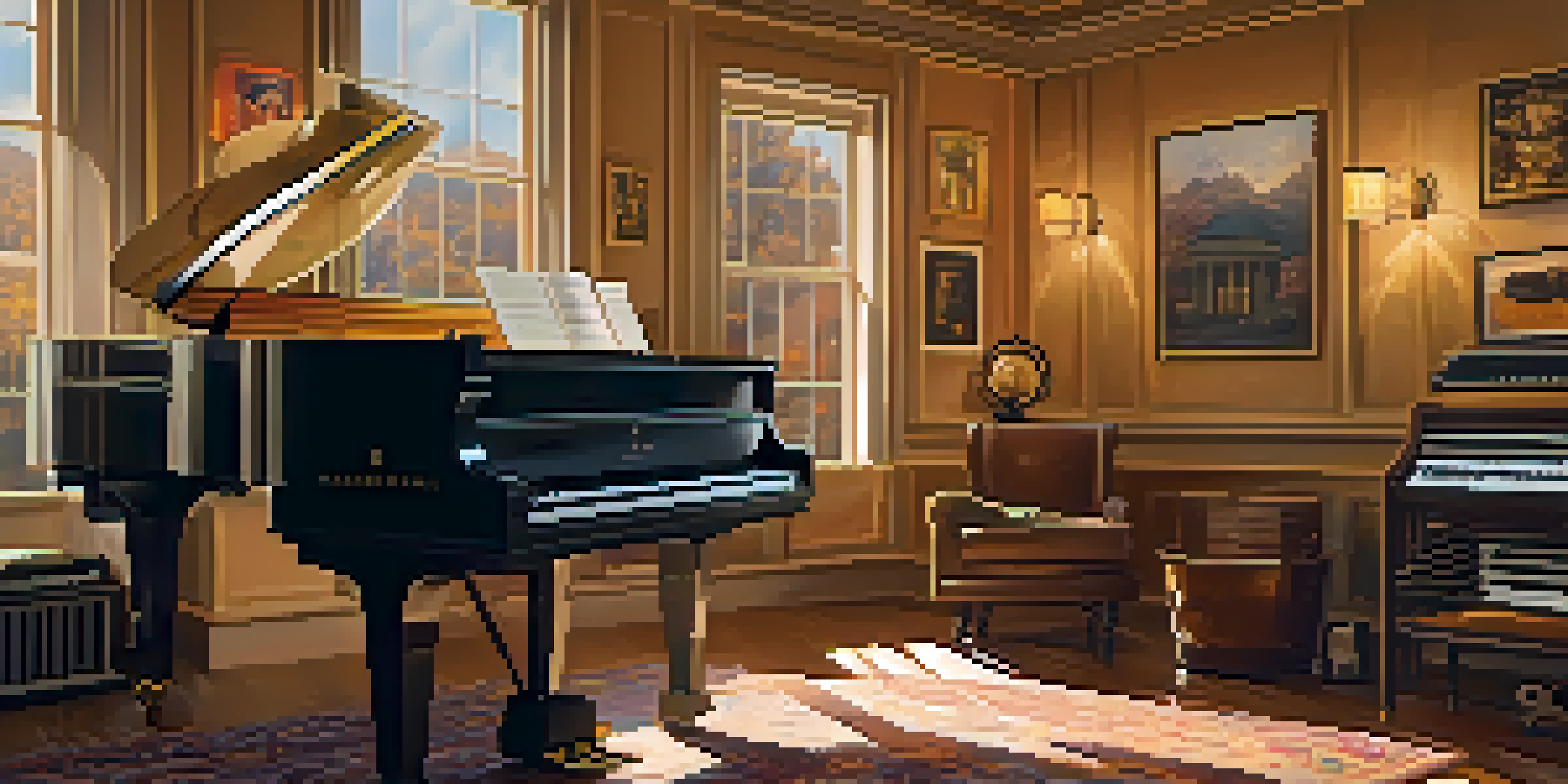Cues and Motifs: Building Musical Identity in Film Scoring

Understanding Cues: The Building Blocks of Film Music
Cues are segments of music that signal specific moments in a film. Think of them as musical signposts that guide the audience's emotional journey. For instance, a rising crescendo might indicate impending danger, while soft strings can evoke nostalgia.
Music can change the world because it can change people.
These cues don't just support the visuals; they enhance storytelling by adding depth to characters and scenes. A well-placed cue can make a viewer feel excitement, sadness, or even suspense. It's fascinating how just a few notes can transform a scene's impact.
In film scoring, composers carefully craft these cues to align with the narrative. They analyze the screenplay, identify key moments, and create music that resonates with the story's emotional landscape. This intentional approach ensures that the music feels like an integral part of the film.
Motifs: The Signature Sound of Characters and Themes
Motifs are recurring musical phrases that represent characters or themes within a film. Imagine them as a character's musical calling card, instantly recognizable and deeply connected to their journey. For example, Darth Vader's theme in 'Star Wars' encapsulates his menacing presence.

These motifs can evolve throughout the film, reflecting character development or emotional shifts. As a character faces challenges or changes, their motif might transform, adding layers to the storytelling. This dynamic quality keeps audiences engaged and invested in the narrative.
Cues Enhance Emotional Storytelling
Cues are musical segments that guide audience emotions and enrich character narratives throughout a film.
By establishing motifs, composers create a cohesive musical identity that ties together various elements of the film. This unity allows viewers to connect emotionally with the characters and themes, making the overall experience more memorable and impactful.
How Cues and Motifs Work Together in Film Scoring
Cues and motifs often work in tandem to create a rich musical tapestry. While cues provide immediate emotional context for specific scenes, motifs build a broader narrative arc. Together, they weave a complex emotional landscape that enhances the storytelling.
Without music, life would be a mistake.
For instance, a cue might accompany a pivotal moment, such as a triumphant victory, while the associated motif subtly plays in the background, reinforcing the character's growth. This layering of music creates a sense of continuity and depth, making the viewer's experience more immersive.
When effectively combined, cues and motifs elevate the film's emotional impact. They guide the audience's reactions, allowing them to feel the weight of a moment or the joy of a resolution. This synergy is what makes film music such a powerful storytelling tool.
The Role of Emotion in Film Scoring
Emotion is at the heart of film scoring, guiding how audiences feel during pivotal moments. Composers use cues and motifs to evoke specific emotions, from joy to sorrow. For example, a heartwarming scene might use gentle piano melodies, while a dramatic moment could feature intense orchestration.
This emotional connection is crucial, as it helps viewers form attachments to characters. When a character faces a challenge, the music can heighten the tension, making the audience root for their success. It's this emotional investment that keeps viewers engaged throughout the film.
Motifs Represent Characters and Themes
Motifs are recurring musical phrases that connect deeply to characters and themes, evolving as the story progresses.
Moreover, the use of cues and motifs to elicit emotion often becomes memorable long after the film ends. Iconic themes can evoke nostalgia and remind audiences of their favorite scenes. This lasting impact showcases the power of music in shaping cinematic experiences.
Cues and Motifs: Techniques in Composition
Composers employ various techniques to create effective cues and motifs. One common approach is the use of orchestration, where different instruments convey different emotions. For example, strings might be used for warmth, while brass can signal power or assertiveness.
Another technique involves repetition and variation. By repeating a motif with slight alterations, composers can keep it fresh while reinforcing its significance. This method allows audiences to recognize the motif while experiencing its evolution throughout the film.
Additionally, composers often draw on cultural or historical references to enhance their cues and motifs. By incorporating familiar musical styles or instruments, they can create a deeper connection with the audience, making the film's music resonate on multiple levels.
Case Studies: Iconic Film Scores and Their Techniques
Examining iconic film scores provides valuable insights into how cues and motifs are utilized. Take John Williams' score for 'Jurassic Park', where the main theme captures the awe and wonder of dinosaurs. The motifs associated with different characters and moments enhance the emotional journey.
Another example is Hans Zimmer's work in 'Inception', where he uses motifs to represent the dream layers. The music builds suspense and urgency, guiding the audience through complex narrative twists. Here, cues and motifs blend seamlessly, pulling viewers deeper into the story.
Technology Transforms Film Scoring
Advancements in technology are reshaping film scoring, allowing for innovative soundscapes and enhanced audience engagement.
These examples illustrate how skilled composers leverage cues and motifs to create memorable soundtracks. Their ability to evoke emotion and connect with the audience elevates the storytelling, showcasing the artistry behind film scoring.
The Future of Cues and Motifs in Film Scoring
As technology evolves, so does the landscape of film scoring. New tools and software allow composers to experiment with soundscapes, blending traditional orchestration with electronic elements. This innovation opens up exciting possibilities for creating unique cues and motifs.
Additionally, the rise of streaming platforms has changed how films are consumed, influencing scoring techniques. Composers are now considering how music will resonate in binge-watching environments, leading to the development of motifs that maintain audience engagement across multiple episodes.

Looking forward, the integration of cues and motifs will continue to play a vital role in shaping musical identity in film. As filmmakers and composers collaborate, we can expect to see even more creative approaches to storytelling through music, enriching the cinematic experience for audiences.